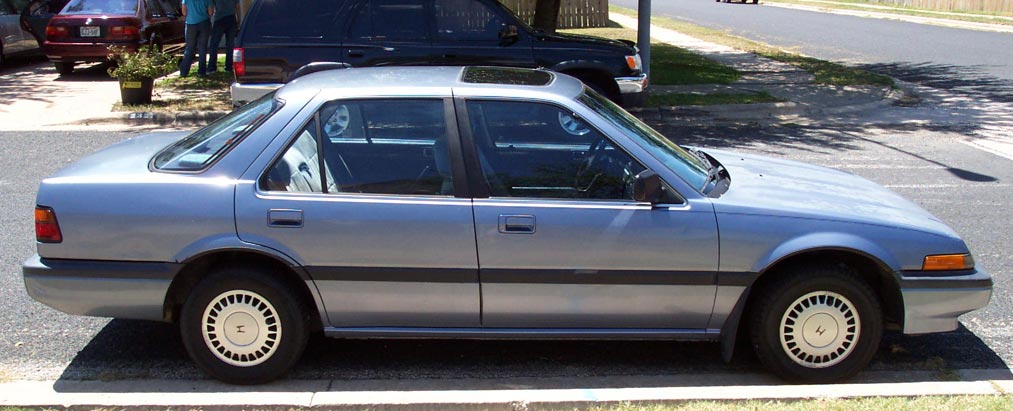

Hatchback coupes gained automatic front shoulder belts in line with a new federal mandate that at least 10 percent of a manufacturer's cars have "passive restraints." As in other cars, these attached between inboard anchors and tracks on the windshield pillars. The third-generation Honda Accord was predictably little changed for the sophomore 1987 model year. "It's sporty enough to rival the costlier, stiffer-riding Prelude as the 'enthusiast's' Honda, and that's saying a lot." As always, its spirited character and high mechanical and ride refinement set it apart from the compact herd." The editors also liked a test LXi hatchback for its zippier performance and all-round competence. After testing an '86 sedan, Consumer Guide found that "espite higher prices and only average performance and fuel economy, the Accord LX remains an excellent buy that's only enhanced by its new, larger size. The midrange LX versions proved to be the most popular of the new Accords, offering most LXi features for not much more money than the plain DX versions. ©2007 Honda via Wieck The 1986 Accord LXi models boasted 110 horsepowe. The LXi duo included a power glass sunroof that was unavailable on other models. Among several new convenience features were a fold-down rear seatback for sedans (with security keylock on the rear parcel shelf) and standard power antenna and door mirrors for LX and LXi models.
#1986 honda accord lxi manual
Other models had a two-barrel carburetor and 98 horsepower.īoth engines teamed with five-speed manual and optional four-speed automatic transmissions. LXi models came with Honda's new electronic multiport "Programmed Fuel Injection" and claimed 110 horsepower, a new high for Accord. The four-cylinder engine retained a single overhead camshaft, but was a clean-sheet design displacing 2.0 liters instead of 1.8.
#1986 honda accord lxi plus
Models were comprised of coupes and sedans in base DX and nicer LX trim, plus new LXi versions. Front and rear axle widths were broadened, which combined with a redesigned four-wheel independent suspension to improve handling and roadholding that were already quite sporty for a family compact. The new models were also a bit wider (66.7 inches) and heavier by 100-200 pounds depending on body style and equipment. Length extended to 174.8 inches on hatchback coupes and to 178.5 on sedans. Wheelbase went up a sizable 5.9 inches to 102.4, which helped increase rear-seat space. Smooth new styling, announced by hidden lamps, complemented the usual low-slung Accord stance and brought larger dimensions. About the only things carried over were front-wheel drive and transversely mounted four-cylinder engine. Most cars billed as "all new" really aren't, but the 1986 Honda Accord truly was. The 1989 addition of notchback coupe models further enhanced Accord's popularity.


Even the '86s, for all their obvious changes, maintained the key attributes that made Accords so appealing to American consumers. Yet despite the model proliferation, the Accord remained Honda's chief moneymaker. Indeed, the company would soon be making more money in the New World than it did in Japan. The same could be said for the entire Honda line, which was fast expanding to include nifty two-seat Civic-based coupes - mini sports cars called CRX - as well as an upscale compact and large sedan sold separately under a new brand name, Acura.Īll this testified to Honda's roaring success in North America. The result was an Accord that managed to be both sportier and, in new top-line LXi trim, more luxurious. The 1986 Honda Accord kicked off the car's third design generation with a sleek new look, larger dimensions and more power. ©2007 Honda via Wieck The 1986 Honda Accord had a sleek new design and more power.


 0 kommentar(er)
0 kommentar(er)
